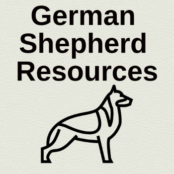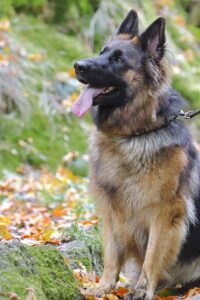Table of Contents
Introduction
Owning a German Shepherd is an incredible experience. These loyal and intelligent dogs are not just pets; they are family. However, taking care of a German Shepherd double coat can be a challenge. Grooming plays a crucial role in maintaining their health and appearance. This blog post will guide you through the intricacies of grooming and maintaining that beautiful double coat.
Types of German Shepherd Coats
Long Haired German Shepherd
Long haired German Shepherd’s have long flowing, softer coats. They may or may not have an undercoat. These dogs are not considered breed standard if they have no undercoat. Even with an undercoat they will be frowned upon in any AKC standard competition. Still, I think they are beautiful dogs! Just be prepared for dealing with mats and tangles.
Plush Coated German Shepherds
Plush coated German Shepherds have a longer fuller coat with the dense undercoat, but it is not as long and flowing as the long coated German Shepherds. This tends to be the coat style American AKC judges prefer.
Short or Stock Coated German Shepherds
Short coated Germans Shepherd’s have shorter, slicker coats that lay flat on the body. They have short fringe on the tail and hind and front legs and a bit fuller coat around the neck. Their coats are generally wiry to the touch and have dense undercoats.
Understanding the German Shepherd Double Coat
Layers of the Double Coat
The German Shepherd’s double coat consists of two distinct layers. The outer guard coat is made up of long, coarse hairs that protect against dirt and water. Beneath this lies the undercoat, which is softer and denser, providing insulation against cold and heat. Together, these layers make the double coat a versatile and functional feature of the breed.
Functions of the Double Coat
The double coat serves several essential functions. It acts as a natural barrier against environmental elements, shielding the dog from rain, snow, and UV rays. Additionally, it provides excellent insulation, helping to regulate the dog’s body temperature throughout the year. In winter, the undercoat keeps your German Shepherd warm, while in summer, the shedding of the undercoat allows for better airflow.
Seasonal Shedding Patterns
German Shepherds are known for their seasonal shedding, often referred to as “blowing coat.” This typically occurs twice a year—in spring and fall—when the dog sheds its undercoat to adapt to the changing weather. Understanding these patterns can help you better manage the shedding and keep your home cleaner.
Grooming Essentials
Necessary Tools for Grooming the Double Coat
Having the right tools is essential for grooming a German Shepherd effectively. A slicker brush is excellent for removing loose hair and dirt from the outer coat. An undercoat rake helps tackle the dense undercoat, while a bristle brush smooths the hair and adds shine.
Brushes and Deshedding Tools
For optimal grooming, you’ll need a combination of brushes and deshedding tools. The slicker brush is useful for regular maintenance, while the undercoat rake is ideal for high-shedding periods. Additionally, deshedding tools like the Furminator can significantly reduce loose hair by reaching deep into the undercoat. I love my furminator for my GSD Jasper.
Grooming Products
Choosing the right grooming products is equally important. Opt for shampoos and conditioners formulated for dogs with double coats. These products help maintain the coat’s natural oils and prevent dryness. Detanglers can also be beneficial for dealing with mats and tangles.
Regular Grooming Routine
Suggested Frequency of Grooming Sessions
A consistent grooming routine is vital for keeping your German Shepherd’s coat in top condition. Aim to groom your dog at least once a week, increasing the frequency during shedding seasons.
Personally, I groom my German Shepherd dog Jasper, just about every day and do his nails at least weekly. The trick with nails is slow but often.
Step-by-Step Guide to an Effective Grooming Session
- Brushing:
- Start with a slicker brush to remove loose hair and dirt.
- Use the undercoat rake to tackle the dense undercoat.
- Finish with a bristle brush to smooth and add shine.
- Bathing:
- Choose a gentle, dog-specific shampoo.
- Rinse thoroughly to remove all soap residues.
- Dogs don’t need bathing often. It upsets the oil balance of their skin. However, if you let your dog swim in a chlorinated pool be sure to rinse him off good when he gets out.
- Drying:
- Use towels to absorb excess water. Jasper loves this!
- Follow up with a blow dryer on a low heat setting. I’ve never done this with Jasper as he is a short coat German Shepherd and a good toweling is generally enough.
- You will probably have to train your dog to tolerate this slowly.
- Nail Trimming and Ear Cleaning:
- Trim nails carefully to avoid cutting the quick. I like using the nail trimmer for tips then following with a dog nail Dremel. Taking off some of the top of the nail will encourage the quick to recede. The trick to nail trims is patience. That and cookies! If you only get one paw done and your dog seems stressed, stop and try again later.
- Clean ears with a dog-safe solution to prevent infections. Mostly, I just leave Jasper’s ears alone. He has never had an ear infection. I do handle his ears daily as well as all his body. This is an important practice to get your dog use to from puppyhood.
Managing Shedding
Identifying Shedding Seasons
Recognizing when your German Shepherd is likely to shed more can help you prepare and manage the excess hair. Spring and fall are the primary shedding seasons, but individual dogs may vary.
Tips for Effective Management
Increasing the frequency of grooming during shedding seasons can help manage loose hair. Adjusting your dog’s diet to include omega-3 fatty acids can also improve coat health and reduce shedding. However, German Shepherds shed, a lot.
Using Deshedding Tools
Deshedding tools are invaluable during high-shedding periods. Tools like the Furminator can reach deep into the undercoat, removing loose hair before it ends up all over your home.
Common Grooming Challenges
Dealing with Mats and Tangles
Mats and tangles can be a common issue for German Shepherds, especially long haired and plush varieties. Regular brushing helps prevent them, but if they do occur, use a detangler spray and gently work through the mat with a comb.
Skin Conditions
Skin conditions like dryness or allergies can affect your dog’s coat. Recognize the signs early and consult your vet for appropriate treatments. My German shepherd gets both hot spots and seasonal allergies. Lots of scratching going on at our house!
Professional Grooming Services
While regular at-home grooming is essential, professional grooming services can be beneficial for dealing with stubborn mats, skin conditions, or simply giving your dog a thorough clean.
Health Benefits of Regular German Shepherd Grooming
Promotes Healthier Skin and Coat
Regular grooming promotes a healthier skin and coat by distributing natural oils, removing dead hair, and preventing mats and tangles.
Early Detection of Skin Issues or Parasites
Grooming provides an opportunity to check for skin issues or parasites like fleas and ticks. Early detection can lead to quicker treatment and better overall health.
Strengthens the Bond Between Owner and Pet
Grooming sessions can strengthen the bond between you and your German Shepherd. It’s a time for gentle care and attention, which your dog will appreciate. Jasper loves grooming! Well, except for nail trimming.
Conclusion
Maintaining a regular grooming routine for your German Shepherd double coat is crucial for their health and appearance. With the right tools and techniques, you can keep your dog’s double coat in excellent condition. Remember, grooming is not just about looks; it’s an essential aspect of overall health and well-being. Happy grooming!

